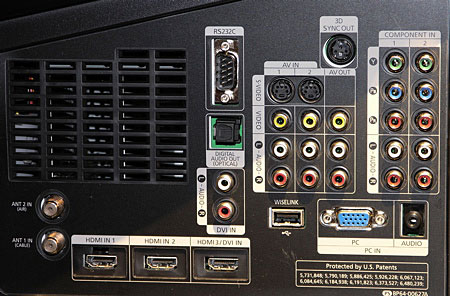Samsung HL-T5687S 1080p DLP Rear Projection HDTV Page 2
The Color Gamut control offers three options: Wide, Normal, and sRGB. Out of the box, sRGB proved to be the most accurate, though the results could be improved with a full calibration (see "Measurements").

The Detailed Settings selection is a subset of the Picture menu that opens up even more adjustments. I ultimately didn't use any of them other than to see what they could do. Black Adjust darkens the gamma at the dark end of the brightness range, which as far as I could tell merely has the effect of crushing the blacks; I left it Off. Dynamic Contrast provides four settings (including Off) that are said to provide optimal contrast. It did punch up some darker scenes, but at the cost of a harsher look in brighter ones. I preferred to leave it Off.
The Gamma control offers some benefit but also shifted the black level, requiring readjustment of the Brightness control with every change to maintain a correct setup. I left it at its default, zero setting.
The White Balance control does shift the color temperature, but it's an invitation to the user lacking the right tools and experience to simply mess up the picture.
The individual adjustments in the "My Color Control" menu are another feature best left at the factory setting.
The two-position (On/Off) Edge Enhancement control sounds like an invitation to trouble. But while its operation was relatively subtle, I never found it offered any benefit. The set's sound is respectable. But it's no substitute for a good external audio system.
Calibration Commentary
Out of the box, the Samsung performed best in the Warm2 color temperature setting, in Movie mode, and with the sRGB Color Gamut selected. Most of the comments in the section to follow (Screenings) refer to the post calibration results.
 On calibrating this set, I'll just comment here that the procedure is incredibly precise, but also highly complex, atypical of calibration procedures in general, and lengthy. (The calibration of Samsung's LCD flat panel sets is far more straightforward.) Even if you are able to find a competent technician willing to tackle a new Samsung RPTV and equipped with the necessary training and equipment to do so, be prepared to pay more than the usual calibration fee.
On calibrating this set, I'll just comment here that the procedure is incredibly precise, but also highly complex, atypical of calibration procedures in general, and lengthy. (The calibration of Samsung's LCD flat panel sets is far more straightforward.) Even if you are able to find a competent technician willing to tackle a new Samsung RPTV and equipped with the necessary training and equipment to do so, be prepared to pay more than the usual calibration fee.
Screenings
Even before calibration, I was impressed by the Samsung's punchy, vibrant, sharp picture. After calibration it was even better. Greens, in particular (depending as always on the program material), were often exceptional, and less artificial looking than on most digital sets.
I did, however, find that the set's colors could be a little intense, with flesh tones tending to orange on some material. Backing off on the color control helped significantly.
The Samsung also had first-rate resolution. The best DVDs looked good, the best HD discs often exceptional. Most of my HD viewing was from 1080p/60 sources, which produced excellent results. On superior HD releases like Kingdom of Heaven, (Blu-ray), both the color and resolution from the Samsung were often striking.
If color and resolution were the Samsung's strengths, it also had significant weaknesses. It uses a high gain screen, as do most rear projection sets. The brightness in the center of the screen measured twice as high as the brightness halfway from the center to the top or bottom. And there was a shift in color, as well, with a subtle blue tint above and below the center. But it was clearly always there.
This Samsung is very bright—pushing 100 foot-Lamberts in Movie mode. This makes the set slightly uncomfortable to view in subdued room lighting. But the Samsung has no user accessible iris adjustment, either fixed or dynamic, that might help compensate for this.
And the high brightness of the set seriously compromises the Samsung's deep blacks. Its black level is one of the poorest we've measured in a recent digital set—of any type.
The Samsung also has some convergence issues, particularly at the top half of the screen where red is misaligned by a pixel or slightly more. This likely originates in the optical path, since there can be no pixel misalignment in a single-chip DLP.
The set earned a fair grade on my mix of standard definition video processing tests and it properly deinterlaced 1080i-to-1080p material as tested on the HD HQV Benchmark test disc. But did not recognize and properly process 3/2 pulldown with a 1080i film source. Nevertheless, distracting artifacts were rare on most normal program material.
The Samsung will accept a 1080p/24fps input, but it converts it internally to 1080p/60fps prior to display. I also found variations in how it behaved 1080p/24 from the disc players we had on hand, so I sent 1080p/60 to the set for all of my HD disc viewing.
Conclusions
The Samsung does have its strengths, not the least of which are fine color performance and good resolution. It's also relatively inexpensive for a 56-inch set from a major manufacturer.
But when a DLP rear projection set is outperformed in its ability to produce deep, rich blacks by many LCD flat panel displays—including Samsung's own LN-T5265F (which impressed us greatly when I reviewed it recently for our sister site UltimateAV)—I have to scratch my head. Yes, the LCD set is smaller and, at least at list prices, much more expensive. But it's clearly the better set.
The Samsung HL-TS5687S offers excellent detail, and fine color at an attractive price. Its most significant detraction is its poor black levels and hot spotting on the screen.





























































